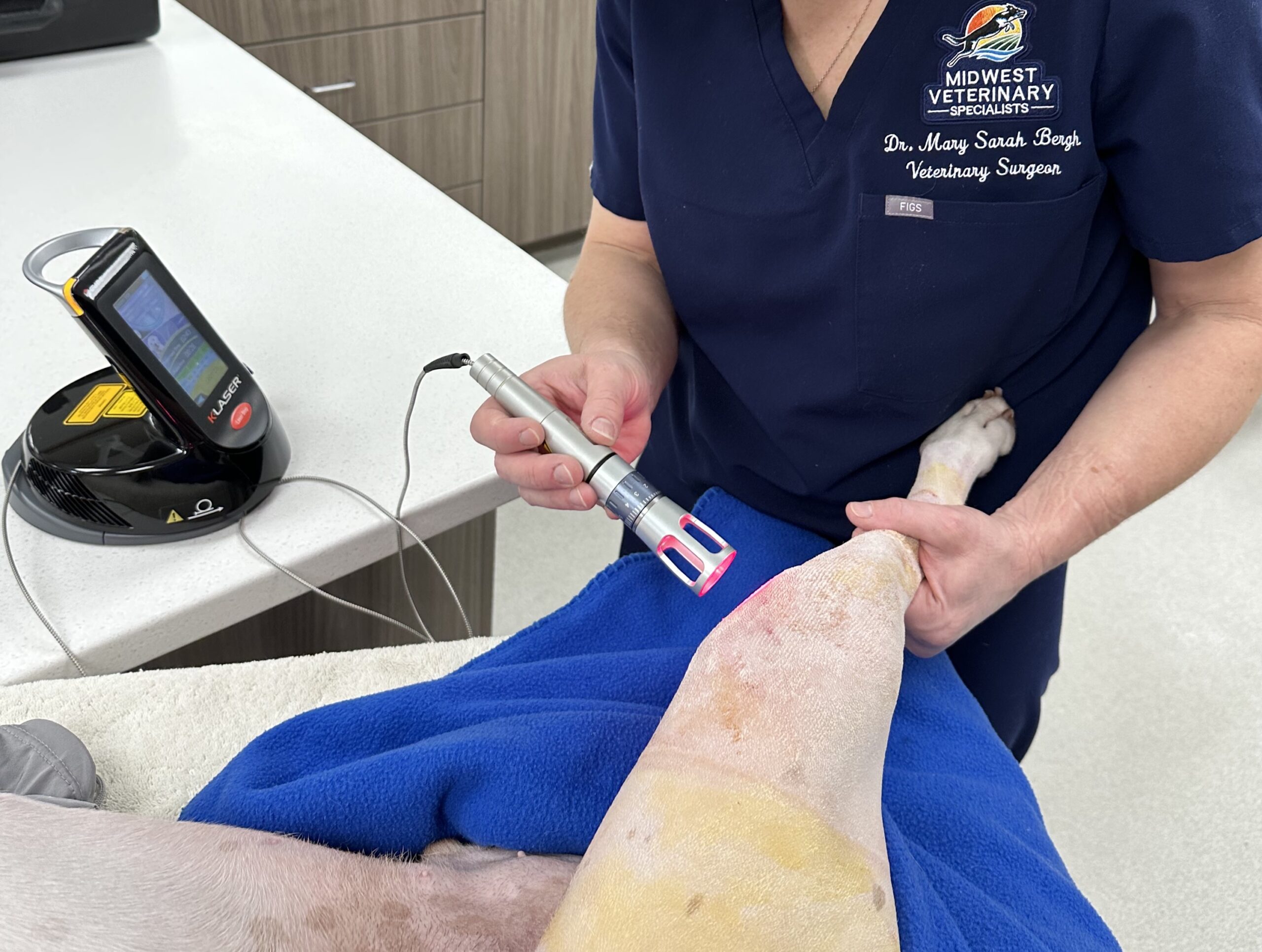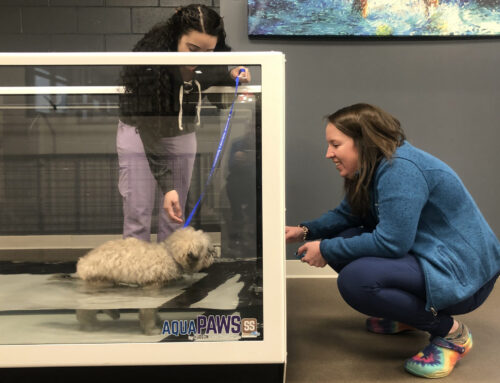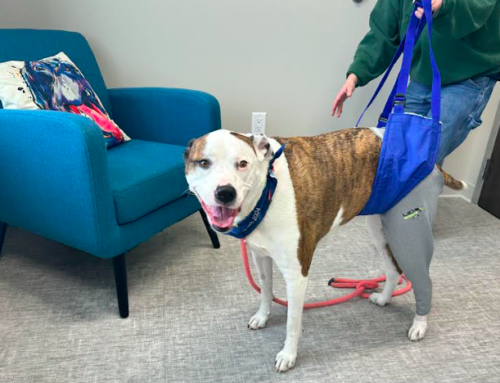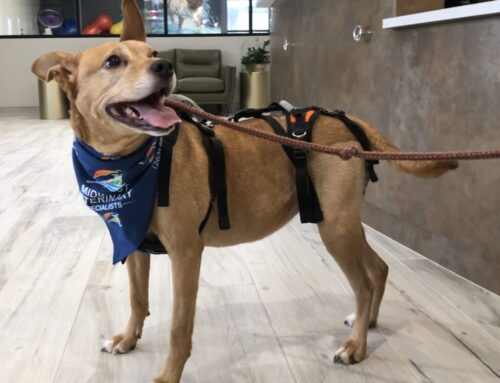Photobiomodulation (i.e., laser therapy) is a non-invasive, drug-free procedure that can be used for numerous medical conditions in pets to accelerate healing, relieve pain, and decrease inflammation. Our Midwest Veterinary Specialists team wants to provide information about laser therapy to help you determine if your pet can benefit from this procedure.
Pet laser therapy terminology
Laser is an acronym for Light Amplification by Stimulated Emission of Radiation. Laser therapy uses light to stimulate non-harmful and nonthermal reactions inside cells and cause a beneficial therapeutic outcome. Lasers classified as 3b and 4 can be safely used in veterinary rehabilitation. Relevant terminology includes:
- Wavelength — Wavelength determines light energy color and classification and is the critical variable for determining laser penetration and tissue absorption. Ideal wavelengths for therapy are between 600 and 1000 nanometers (nm), with shorter wavelengths used for superficial tissue, and longer wavelengths to penetrate deeper tissues.
- Coherence — Spatial coherence is the degree to which light focuses in a beam, and temporal coherence is the degree to which light has a single frequency. These factors differentiate laser light from sunlight, which allows light to be focused at a particular wavelength on the intended treatment spot, leaving adjacent tissue unaffected.
- Joule — A joule is an energy unit used to measure the energy delivery dose.
Pet laser therapy mode of action
Laser therapy promotes tissue repair, reduces inflammation, and decreases pain by using specific frequencies to cause physiological changes at the cellular level. These effects include:
- Increased adenosine triphosphate (ATP) production — ATP is a coenzyme that provides energy to drive many processes in living cells. Increased ATP production supplies cells with the necessary energy for healing.
- Increased reactive oxygen species (ROS) production — ROS are natural cellular oxidative metabolism byproducts that play important roles in modulating cell survival, cell death, cell differentiation, and cell signaling, producing inflammation-related factors, and activating anti-oxidant properties. Increased ROS production promotes healing and decreases inflammation.
- Increased nitric oxide (NO) production — NO promotes new blood vessel formation, controls the inflammatory and immune responses, and mediates vascular dilation and constriction.
- Increased endorphin production — Endorphins are hormones released by the hypothalamus and pituitary gland, typically in response to pain or stress, that act as natural painkillers.
- Reduces substance P production — Substance P triggers certain inflammation types and plays a role in pain perception. Decreasing substance P production relieves pain and decreases inflammation.
- Decreased bradykinin and histamine formation — Bradykinin and histamine promote inflammation in the body, and decreasing these substances helps lower the body’s inflammatory response.
These cellular effects lead to pain relief, decreased inflammation, decreased swelling, improved circulation, enhanced wound healing, improved tendon and ligament fiber strength, increased collagen synthesis, and slowed tissue degeneration.
Pet laser therapy applications
Laser therapy is beneficial for numerous veterinary medical conditions and can be used on muscle, tendon, ligament, connective tissue, bone, and skin tissue. This therapy also makes an excellent adjunctive therapy to other treatment approaches, such as surgery, hydrotherapy, therapeutic exercise, and ultrasound. Different wavelengths are used to treat different conditions. At Midwest Veterinary Specialists, we utilize cutting-edge technology with a K-laser Cube 4 class 4 laser, that has has 4 different wavelengths and uses dynamic therapy with several pulse frequencies to produce a combination of analgesia, inflammation reduction, biostimulation and antimicrobial effect, thus accelerating the regeneration of tissues and increasing cellular energy.
- Infrared wavelengths — Wavelengths from 780 to 830 nm are used for deep tissue penetration, and can be applied for the following conditions:
- Sprains and strains
- Deep wounds
- Hematomas
- Ligament and tendon injuries
- Inflammation (e.g. joints, ears, muscles)
- Joint injuries
- Arthritis
- Myofascial trigger points
- Chronic and acute pain
- Non-union and small bone fractures
- Lick granulomas
- Visible red wavelengths — Wavelengths from 630 to 700 nm are used for shallow tissue penetration, and can be applied for the following conditions:
- Wounds and abrasions
- Dental disease
- Post-surgical wounds
- Skin disorders
Pet laser therapy sessions
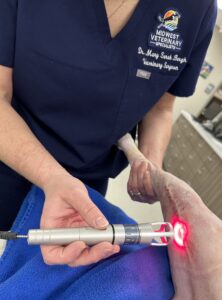
Laser therapy effects are cumulative, which means that your pet should improve after each treatment, and the improvement should last longer after each session until a plateau is reached or their condition resolves. Sessions can last 15 to 30 minutes, depending on your pet’s problem. Everyone in the room, including your pet, should wear protective goggles, because therapeutic lasers can cause permanent retinal damage. Laser therapy sessions are usually recommended daily or every other day initially, and then less frequently as the pet’s condition improves. Pets affected by chronic issues, such as arthritis, may need ongoing sessions to manage the problem. Laser therapy is extremely safe, but contraindications include laser use over a cancerous tumor and a pregnant pet’s uterus.
Laser therapy treatment benefits many pet health conditions. If you think your pet can benefit from laser therapy, contact our Midwest Veterinary Specialists team to schedule an appointment.


